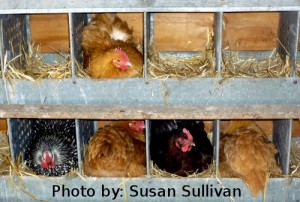 Because so many variables are involved, we cannot predict exactly when your chickens will start to lay, but we can give some estimates.
Because so many variables are involved, we cannot predict exactly when your chickens will start to lay, but we can give some estimates.
Pearl White Leghorns are our earliest layers and can start to lay as early as 4 1/2 to 5 months as can Red Stars and Black Stars. Most other breeds will typically start around 5-7 months.
If your chickens are older than this and they haven’t yet started to lay, there are several things to check:
- Are they getting ample nutrition? Are you using a good quality commercial layer feed? Also, surprisingly, feeding too many table scraps can reduce laying because the table scraps have a different balance of nutrition than their normal feed. But in moderation, table scraps are excellent for them.
- Are the birds in a stress-free environment? Noisy dogs, inadequate protection from the elements, excessive handling, etc. can cause stress that slows the onset of laying.
- Good hygiene is important. Clean waters and feeders frequently. Provide a continual supply of fresh drinking water. Avoid letting feed come in contact with the ground.
- Are the birds healthy? Are there any signs of parasites or mites? Gail Damerow’s The Chicken Health Handbook is an excellent reference for more information.
- Are they warm enough? This time of year, that typically won’t be a problem, but it’s good to be aware of come fall and winter. Cold birds won’t lay well. Above 55°F is ideal for them. As the weather warms up this spring and summer, be sure to provide shade and cool water, as heat can also affect laying.
- Lighting plays a big role in laying. This time of year, with the days getting longer, lighting is not likely to delay laying except possibly in the far north.
- Molting can also affect laying, but it more commonly occurs in the fall. During a molt, your hens will typically slow or stop their laying as they lose and replenish their feathers.



I have 7 Rhode Island Reds that are 14 weeks old – when can I start them on regular chicken feed versus the starter feed…thank you!
I really like the help and tips; I was wondering why my 6 months old hen laid only small egg; however I like all the help how to with my 70 hens. If I start to confine them, will they get slow on egg laying.
I like to ask how to keep their legs free of scale. I have 4 hens that have it, no mites anywhere. I try to put vasoline on there legs, but I do not see a change. What can I do and where did this come about. Appreciate the help and thank you sincerely.
The temperatures in the Southern Rockies have been erratic this year. Our temperature would be in the upper 30’s to lower 40’s and then would drop to around 20 degrees. Our chickens would lay great eggs one week and then stop the next week and this last so far from the beginning of April to now, on going.
We aren’t the only ones going through this wave. I think if anyone in my area is having trouble with eggs, in my opinion, this is a major factor of why our hens are not laying right now. My friend says it helps to give them warm water.
Last year my new chicks set a new record for starting to lay those first eggs. One of my while Leghorns was the first to lay…exactly one week before she turned four months old. What a surprise. I do have to say the feed really makes a difference. Would not be without those minerals “Ava Charge” that I can put into their water.